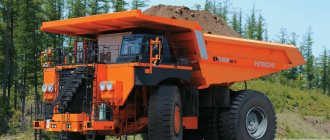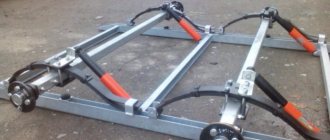In Soviet times, there were not many trucks that would occupy a huge niche in almost all industries of that time. Among these few, two models stand out: ZIL-130 and GAZ-53. Both of these trucks were designed around the same time, both of them were in mass production for a very long time, and finally both of them became legends of the Soviet Union. Millions of drivers have driven this technology and each of them has many memories associated with it. In this article we will compare these two trucks according to their main technical characteristics, i.e., what the manufacturer tells us. Let's start with the GAZ-53 truck.
Its production was established at the Gorky Automobile Plant in 1961. The truck's carrying capacity was 4.5 tons. Initially, the truck was equipped with a six-cylinder engine with a power of only 82 hp, which was quite small for a truck of this class (later the power was increased to 115 hp, and even further to 120 hp). With this engine, high fuel consumption of up to 25 liters per 100 kilometers was observed. The gearbox is four-speed manual.
The wheels are rear-wheel drive, and the cab layout is hooded. At the rear there was a body with wooden sides that folded down in all directions. The speed developed by the GAZ-53 is 90 km/h. The cabin accommodated two people, but if desired, three could sit. During production, the truck had many modifications for various purposes. Serial production of the GAZ-53 ended in 1993.
The last mass-produced car of the Likhachev Plant
The colorful name of the car “Bychok” most likely arose as a kind of response to the “Gazelle” of the Gorky Automobile Plant. It more than successfully launched on the market several years earlier than ZIL-5301. Some attribute this name to the then mayor of Moscow Yuri Luzhkov. Which, as you know, was partial to the Likhachev Plant and actively contributed to the promotion of its products on the domestic market. Everything about the latest mass-produced ZIL car is in this publication.
By the way, the factory and industry index “5301”, which was very popular in the late 90s/early 2000s, received the Bychok car by mistake, through the light hand of a certain employee of the Ministry of Automobile and Tractor Industry. When issuing a certificate for the production of this model, the first digit was mixed up (according to the industry standard, there should have been a three).
This oversight was not immediately noticed. And when the error was discovered, it was too late: the name had already spread throughout the technological documentation. And the three-ton “Bull” began to “wear” an index corresponding to the heavy load-carrying class.
Main characteristics of GAZ-53
GAZ-53 is the third generation of trucks produced by the Gorky Automobile Plant. Until 1997, the GAZ-53-12 modification, produced since 1983, was in serial production. The Gorky Automobile Plant continues to produce components and spare parts for cars that continue to be successfully operated on Russian roads.
The truck was produced in the following versions:
In the classic version, the number of modifications was 10 options , including a hybrid variation running on natural and liquefied gas, as well as an army version with engines of different power. In a special version, the truck is used as a mobile repair shop and a ladder truck. The overall dimensions of the GAZ-53 are 6395 mm , 2.02 m , and 2220 mm .
3740 mm long 2170 mm wide and can carry up to 4.5 tons of cargo . The cabin can accommodate 3 people. The truck is equipped with a ZMZ 53-11 engine with a volume of 4.25 liters and a power of 120 hp .
Technical characteristics of ZIL-5301 “Bychok”
In addition to being used in commercial cargo transportation, “Bychok” is also widely used as...
Dimensions and weights
- Length: 6.195 m (7.165 m - extended version); Width: 2.319 m; Height: 2,365 m.
- Wheelbase: 3,650 m.
- Front track: 1.832 m; Rear track: 1,690 m.
- Ground clearance: 180 mm.
- Turning radius: 7.8 meters.
- Load capacity: 3 tons.
- Parameters of the onboard cargo platform as standard: 3750x2254x450 mm.
- Loading height: from 765 mm to 1050 mm.
- Weight: loaded (with awning) – 3695 kg; Full (permissible) – 6950 kg.
- The permissible load on the front axle is 2350 kg.
- The permissible load on the rear axle is 4900 kg.
- Disc wheels, 6.5Jx16H2; Tubeless tires “225/75R16С”.
Engine ZIL-5301
All the years of its production, the Bychok truck was equipped with an automobile modification of the tractor 4-cylinder diesel engine D-245 (volume 4750 cm³) from the Minsk Motor Plant (MMZ). There were separate experiments on equipping the ZIL-5301 with imported engines: Caterpillar (135-horsepower SAT-3054); Renault (136 hp Renault MIDR 040226F4); Bulgarian 120-horsepower "Vamo". But they remained at the level of experiments and experiments.
It cannot be said that the D-245 engine of the mid-nineties and early 2010s used for the “Bull” is the same engine. During this time, this turbocharged diesel engine went through a number of upgrades, thanks to which its power increased from 109 to 136 hp, and the environmental class was raised from zero to Euro-3 (it was also planned to introduce the Euro-4 standard).
Characteristics of ZIL-130
The Soviet and Russian truck was put into production at the Moscow Automobile Plant named after. Likhachov in 1963. Production of the car on an industrial scale was discontinued in 1994, but from 1995 to 2014. The Ural Automobile Plant produced the latest modification of the ZIL-130, intended for the needs of the army.
From 1965 to 1986, about four dozen modifications of the family of medium-duty vehicles were produced. In addition, 10 variants of serial fire fighting vehicles were produced on the basis of the ZIL-130. The first basic car (chassis for special vehicles) was produced with a 148-horsepower engine with a load capacity of 4.5 tons . Subsequently, the engine power was increased to 150 hp , the load capacity was 5000 kg , and the service life increased by 65 thousand km, to 200 thousand kilometers . In the modification ZIL - 130-76, the load capacity was 6000 kg , and the service life increased to 400 thousand km . In the latest production modification, the car was equipped with three independent braking systems.
Weight and dimensions of the truck:
The truck has a ventilation hatch and windows in the cab; good visibility is provided by a panoramic windshield. In the body with a folding tailgate, benches for up to 16 people can be placed on the bars on the sides. The equipment for the basic model includes an awning with arches, which can be installed if necessary. 29 liters per 100 km at an average speed of 60 km/h . The engine is associated with a five-speed manual transmission. The cost of a ZIL-130, depending on equipment and technical condition, ranges from 50 thousand rubles. up to 300,000 rubles .
Distinctive features of trucks
The colossal popularity of the “one hundred and thirtieth” Moscow Automobile Plant named after. Likhachov was explained not only by its excellent technical characteristics, but also by a large number of modifications. The most commonly used vehicles were trailers and articulated dump trucks. On the basis of the ZIL-130, on-board vehicles and dump trucks, fire engines and truck cranes, vans and tank trucks were created.
With a carrying capacity of 3 tons, the “one hundred and thirty” can tow a trailer weighing up to 8 tons. The three-seater cabin of the ZIL-130 is comfortable, and the separate driver’s seat is adjustable in length, height and backrest tilt, while in the GAZ-53 the three-seater seat is a solid sofa. The increased width and height of the ZIL-130 allows increasing the load capacity to six tons instead of the three tons of the Gorky truck.
The fuel consumption of the “one hundred and thirty” per 100 km is 7 liters more, but at the same time it uses cheaper diesel fuel, and taking into account its large load capacity, it is economically profitable. By its design, ZIL-130 is stronger than GAZ-53. A practical and resource-reliable engine provides the truck with excellent maneuverability, cross-country ability and reaches speeds on good roads of up to one hundred kilometers per hour.
Owner reviews about the ZIL-5301 “Bychok” car
Judging by numerous reviews, “Bychok” is generally a good car, subject to constant care and close attention to it. In this sense, ZIL-5301 is quite demanding. As one experienced “bull driver” put it, “if the owner himself drives the Bychka, then the car will make money, but if the driver drives it, then in a couple of months he will have to sell it.”
What none of the owners have any particular complaints about is the Minsk “Bychka” engine - reliable, high-torque, and economical in operation. With the carrying capacity, everything is more than normal: the car can easily “take on board” the “promised” three tons, and beyond this limit. A loaded ZIL-5301, according to the owners, “eats” about 20 liters of diesel fuel per 100 kilometers; empty - about 12. The transmission elements - the clutch and gearbox - also do not cause any problems during the entire period of operation, which are undoubtedly reliable and durable.
Cabin interior of ZIL-5301 “Bychok”.
The same cannot be said about the rear axle gearbox: it breaks, the greatest difficulties are caused by the differential side gears, crosspieces and satellites. The disadvantage that almost everyone talks about is the low quality of the metal. Unfortunately, the “Bychka” cabin quickly and uncontrollably corrodes and begins to “bloom” with rust already in the first years of operation. The cabin, however, is quite warm, spacious and comfortable. But it’s noisy, that’s a fact! Nothing yet for the end of the 20th century, but the noise and vibration protection of the driver’s workplace absolutely does not meet the standards of the 21st century.
Drivers like the ventilation hatch in the cabin, but it regularly leaks when it rains, and the high beams are ineffective. The engine compartment is cramped, not thought out, “you can’t get into anything.” It is felt that the D-245 engine was really considered as a “temporary measure”. Regarding the layout of other components, there are also rather politically incorrect statements from owners: “Whoever developed the rear brakes (fastening the pads and the handbrake) would have killed the reptile.”
Many owners call Bychok a “constructor for adults”: “As a result, after several years of working at Bychok, I became a top-class mechanic.” A lot of minor breakdowns and problems that arise regularly and periodically.
Anyone who is thinking about buying a used ZIL-5301 must have strong nerves, intelligence and “golden hands” (or urgently begin to “grow” them). However, all these troubles are compensated by the cheap price of the machine and its spare parts, its efficiency and profitability in operation.
Who and what is guided by when choosing a truck model
When using a truck to transport goods over short distances, regardless of road conditions, the Gorky Auto product with its comfortable cabin and load capacity twice as large as the GAZ-53 is economically more profitable, chosen by those who need transport services over long distances and in difficult conditions.
The ZIL-130 was produced until 1994, and in total more than 3.5 million copies of various modifications of the car rolled off the assembly line of the Moscow Automobile Plant. Based on the fact that the successful design of the car has made it practically “indestructible” for decades, the popularity of the “One Hundred and Thirtieth” among consumers continues to remain at a high level.
Source
GAZ-53 and ZIL-130: comparison of trucks and which is better
The truck was produced in the following versions:
In the classic version, the number of modifications was 10 options , including a hybrid variation running on natural and liquefied gas, as well as an army version with engines of different power. In a special version, the truck is used as a mobile repair shop and a ladder truck. The overall dimensions of the GAZ-53 are 6395 mm , 2.02 m , and 2220 mm .
3740 mm long 2170 mm wide and can carry up to 4.5 tons of cargo . The cabin can accommodate 3 people. The truck is equipped with a ZMZ 53-11 engine with a volume of 4.25 liters and a power of 120 hp .
GAZ-53 and ZIL-130: comparison of trucks and which is better - Lots of good and useful tips
GAZ-53 is the third generation of trucks produced by the Gorky Automobile Plant.
Until 1997, the GAZ-53-12 modification, produced since 1983, was in serial production. The Gorky Automobile Plant continues to produce components and spare parts for cars that continue to be successfully operated on Russian roads. The truck was produced in the following versions:
- Classical.
- Specialized.
- Dump.
In the classic version, the number of modifications was 10 options , including a hybrid variation running on natural and liquefied gas, as well as an army version with engines of different power. In a special version, the truck is used as a mobile repair shop and a ladder truck. The overall dimensions of the GAZ-53 are 6395 mm , 2.02 m , and 2220 mm .
3740 mm long 2170 mm wide and can carry up to 4.5 tons of cargo . The cabin can accommodate 3 people. The truck is equipped with a ZMZ 53-11 engine with a volume of 4.25 liters and a power of 120 hp .
Characteristics of ZIL-130
The Soviet and Russian truck was put into production at the Moscow Automobile Plant named after. Likhachov in 1963. Production of the car on an industrial scale was discontinued in 1994, but from 1995 to 2014. The Ural Automobile Plant produced the latest modification of the ZIL-130, intended for the needs of the army.
From 1965 to 1986, about four dozen modifications of the family of medium-duty vehicles were produced. In addition, 10 variants of serial fire fighting vehicles were produced on the basis of the ZIL-130. The first basic car (chassis for special vehicles) was produced with a 148-horsepower engine with a load capacity of 4.5 tons .
Subsequently, the engine power was increased to 150 hp , the load capacity was 5000 kg , and the service life increased by 65 thousand km, to 200 thousand kilometers . In the modification ZIL - 130-76, the load capacity was 6000 kg , and the service life increased to 400 thousand km .
In the latest production modification, the car was equipped with three independent braking systems.
Weight and dimensions of the truck:
- Length - 6675 mm .
- Width - 2,500 mm .
- Height - 2,400 mm .
- Ground clearance - 275 mm .
The truck has a ventilation hatch and windows in the cab; good visibility is provided by a panoramic windshield. In the body with a folding tailgate, benches for up to 16 people can be placed on the bars on the sides. The equipment for the basic model includes an awning with arches, which can be installed if necessary.
29 liters per 100 km at an average speed of 60 km/h . The engine is associated with a five-speed manual transmission. The cost of a ZIL-130, depending on equipment and technical condition, ranges from 50 thousand rubles. up to 300,000 rubles .
General characteristics of trucks
The products of the Gorky and Moscow Automobile Plants are characterized by a simple design , which is distinguished by a high level of operational reliability and ease of repair in the field. Unpretentious and economical trucks, produced more than half a century ago, continue to work successfully on Russian roads today. Both vehicles are rear-wheel drive, the clutch is equipped with a hydraulic drive.
https://www.youtube.com/watch?v=9K28y5hpacE
The advantages of both cars are:
- Record low cost compared to similar cars.
- Minimum requirements for fuel quality.
- Availability of all necessary parts for repairs in free access.
- High ground clearance and good maneuverability.
- Small dimensions with the ability to maneuver in urban conditions.
Distinctive features of trucks
The colossal popularity of the “one hundred and thirtieth” Moscow Automobile Plant named after. Likhachov was explained not only by its excellent technical characteristics, but also by a large number of modifications. The most commonly used vehicles were trailers and articulated dump trucks. On the basis of the ZIL-130, on-board vehicles and dump trucks, fire engines and truck cranes, vans and tank trucks were created.
With a carrying capacity of 3 tons, the “one hundred and thirty” can tow a trailer weighing up to 8 tons. The three-seater cabin of the ZIL-130 is comfortable, and the separate driver’s seat is adjustable in length, height and backrest tilt, while in the GAZ-53 the three-seater seat is a solid sofa. The increased width and height of the ZIL-130 allows increasing the load capacity to six tons instead of the three tons of the Gorky truck.
The fuel consumption of the “one hundred and thirty” per 100 km is 7 liters more, but at the same time it uses cheaper diesel fuel, and taking into account its large load capacity, it is economically profitable. By its design, ZIL-130 is stronger than GAZ-53. A practical and resource-reliable engine provides the truck with excellent maneuverability, cross-country ability and reaches speeds on good roads of up to one hundred kilometers per hour.
Characteristics of ZIL-130
The Soviet and Russian truck was put into production at the Moscow Automobile Plant named after. Likhachov in 1963. Production of the car on an industrial scale was discontinued in 1994, but from 1995 to 2014. The Ural Automobile Plant produced the latest modification of the ZIL-130, intended for the needs of the army.
From 1965 to 1986, about four dozen modifications of the family of medium-duty vehicles were produced. In addition, 10 variants of serial fire fighting vehicles were produced on the basis of the ZIL-130. The first basic car (chassis for special vehicles) was produced with a 148-horsepower engine with a load capacity of 4.5 tons . Subsequently, the engine power was increased to 150 hp , the load capacity was 5000 kg , and the service life increased by 65 thousand km, to 200 thousand kilometers . In the modification ZIL - 130-76, the load capacity was 6000 kg , and the service life increased to 400 thousand km . In the latest production modification, the car was equipped with three independent braking systems.
Weight and dimensions of the truck:
The truck has a ventilation hatch and windows in the cab; good visibility is provided by a panoramic windshield. In the body with a folding tailgate, benches for up to 16 people can be placed on the bars on the sides. The equipment for the basic model includes an awning with arches, which can be installed if necessary. 29 liters per 100 km at an average speed of 60 km/h . The engine is associated with a five-speed manual transmission. The cost of a ZIL-130, depending on equipment and technical condition, ranges from 50 thousand rubles. up to 300,000 rubles .
Distinctive features of trucks
The colossal popularity of the “one hundred and thirtieth” Moscow Automobile Plant named after. Likhachov was explained not only by its excellent technical characteristics, but also by a large number of modifications. The most commonly used vehicles were trailers and articulated dump trucks. On the basis of the ZIL-130, on-board vehicles and dump trucks, fire engines and truck cranes, vans and tank trucks were created.
With a carrying capacity of 3 tons, the “one hundred and thirty” can tow a trailer weighing up to 8 tons. The three-seater cabin of the ZIL-130 is comfortable, and the separate driver’s seat is adjustable in length, height and backrest tilt, while in the GAZ-53 the three-seater seat is a solid sofa. The increased width and height of the ZIL-130 allows increasing the load capacity to six tons instead of the three tons of the Gorky truck.
The fuel consumption of the “one hundred and thirty” per 100 km is 7 liters more, but at the same time it uses cheaper diesel fuel, and taking into account its large load capacity, it is economically profitable. By its design, ZIL-130 is stronger than GAZ-53. A practical and resource-reliable engine provides the truck with excellent maneuverability, cross-country ability and reaches speeds on good roads of up to one hundred kilometers per hour.
Modifications of ZIL-5301 “Bychok” cars
The low loading height of the Bychkov (765 mm), good load capacity with compact dimensions, small turning radius and excellent maneuverability were very soon appreciated by many consumers in Russia and the CIS. Further development of the concept of this vehicle, as well as real support from the capital’s authorities, made it possible to create a number of cargo and cargo-passenger modifications on its basis; various special vehicles.
Based on the Bychka, a whole family of small ZIL-3250 buses was created, including 15 and 19-seat modifications (with a base of 3650 and 4505 mm, respectively); as well as a ZIL-32502M ambulance with a single-pitch tire and pneumatic rear axle suspension, and a ZIL-325SHA staff bus. The buses received stabilizers for both suspensions and an anti-lock braking system (ABS).
Who and what is guided by when choosing a truck model
When using a truck to transport goods over short distances, regardless of road conditions, the Gorky Auto product with its comfortable cabin and load capacity twice as large as the GAZ-53 is economically more profitable, chosen by those who need transport services over long distances and in difficult conditions.
The ZIL-130 was produced until 1994, and in total more than 3.5 million copies of various modifications of the car rolled off the assembly line of the Moscow Automobile Plant. Based on the fact that the successful design of the car has made it practically “indestructible” for decades, the popularity of the “One Hundred and Thirtieth” among consumers continues to remain at a high level.
History of the ZIL-5301 “Bychok” model
Already in the early 90s, new economic realities did not at all contribute to the successful sales of outdated and “gluttonous” gasoline medium-duty ZIL trucks. Then the situation only worsened: the demand for these products rapidly collapsed, and the enterprise plunged into a protracted crisis.
Military and government orders dropped sharply, and agriculture, which was left without support, stopped purchasing new trucks altogether... Yesterday the markets of still friendly countries also turned out to be lost. At the same time, a whole new class of society grew and was replenished - small and medium-sized entrepreneurs interested in vehicles for transporting small consignments of goods on short hauls and in cities.
GAZ understood earlier what to do and launched into production light-duty Gazelle trucks and minibuses designed with Ford Transit in mind. Back in 1992, ZIL hastily developed a compact truck of a class higher than the Gazelle - the three-ton ZIL-5301 with a half-hood layout, but they were able to launch it into production only four years later.
The main reason for such a long gap was the lack of a suitable engine for the new model. In 1996, when “Bychok” was launched into production, the main owners of the Likhachev Plant were, as a result of “privatization according to Chubais,” the cooperative “Mikrodin”, which sells household appliances and electronics. We must pay tribute to its founders - Dmitry Zelenin and Alexander Efanov - they tried to carry out the difficult task of survival and development of the enterprise in a “free market”.
Main characteristics of GAZ-53
GAZ-53 is the third generation of trucks produced by the Gorky Automobile Plant. Until 1997, the GAZ-53-12 modification, produced since 1983, was in serial production. The Gorky Automobile Plant continues to produce components and spare parts for cars that continue to be successfully operated on Russian roads.
The truck was produced in the following versions:
In the classic version, the number of modifications was 10 options , including a hybrid variation running on natural and liquefied gas, as well as an army version with engines of different power. In a special version, the truck is used as a mobile repair shop and a ladder truck. The overall dimensions of the GAZ-53 are 6395 mm , 2.02 m , and 2220 mm .
3740 mm long 2170 mm wide and can carry up to 4.5 tons of cargo . The cabin can accommodate 3 people. The truck is equipped with a ZMZ 53-11 engine with a volume of 4.25 liters and a power of 120 hp .
Gas 53
Gas 53 is a Soviet and Russian truck, produced in large series at the Gorky Automobile Plant from 1961 to 1993. The production of the car was completed in 1997. The model is rightfully considered one of the most legendary products of the Soviet automobile industry. The car has been in use for decades, and in some areas it is still used today. At the same time, the Gorky Automobile Plant continues to produce components and spare parts for Gas 53.
The model represents the third generation of medium-duty trucks of the enterprise and is the most popular product of its class in the USSR. A total of 4 million Gas 53 were produced in classic, specialized and dump truck versions.
The car was used not only in the USSR, but also in other countries. Gas 53 was exported to Poland, Cuba, East Germany, Vietnam, Finland, Bulgaria, Laos, Hungary, Mongolia, Romania, North Korea and other countries. Versions for Eastern Europe were again assembled on the territory of Bulgaria. All this made Gas 53 incredibly popular in many countries around the world.
At the end of the 1950s, work began at the Gorky Automobile Plant to create a line of fundamentally new third-generation cars. For most elements and components they were unified. GAZ 56, GAZ 62, GAZ 66 and GAZ 52 were advanced versions and were supposed to replace the existing models. At the same time, the GAZ 52 was considered as an alternative to the obsolete GAZ 51.
It was supposed to be used for distribution on urban and rural roads, because high demands were placed on the vehicle in terms of smoothness, maneuverability and cross-country ability. In the mid-1950s, specialists from the Gorky Automobile Plant created several variations of the GAZ 51 with modified tail and hood, but they were not put into mass production.
The solutions used in these models were subsequently applied to the GAZ 52.
In the early 1960s, designers of the Gorky Automobile Plant presented an experimental version of the GAZ 52G with significant carrying capacity. It was intended for paved roads. On bad roads, the engine power was not enough, and the frame became unusable quite quickly.
The model was not put into production due to significant shortcomings, but it served as a reason for the creation of more powerful units for trucks. As a result, a new GAZ 13 engine appeared, which made it possible to increase the vehicle's carrying capacity to 4 tons. The design of the vehicle had to be modified, changing the dimensions of the onboard platform, strengthening the suspension and frame, and changing the transmission design.
The GAZ 52 model was transformed into the GAZ 52A, but taking into account large-scale changes and increased carrying capacity, they decided to assign it the GAZ 53 index.
Initially, the new product was equipped with a forced engine from the GAZ 51A, since the enterprise’s capacity was not enough to produce advanced engines. again, the GAZ 53 was equipped with an operator cabin from the GAZ 52 and an extended chassis, rear axle and gearbox from the GAZ 51A.
GAZ-53
In 1964, production began of a version with a V-shaped ZMZ-53 unit, a new lining and a hypoid rear axle. It had a carrying capacity of 3 tons and was discontinued a year later. Its place was taken by the Gas 53A modification with reinforced front suspension and increased load capacity. It was produced until 1983 as a chassis and flatbed truck.
Characteristics of ZIL-130
The Soviet and Russian truck was put into production at the Moscow Automobile Plant named after. Likhachov in 1963. Production of the car on an industrial scale was discontinued in 1994, but from 1995 to 2014. The Ural Automobile Plant produced the latest modification of the ZIL-130, intended for the needs of the army.
From 1965 to 1986, about four dozen modifications of the family of medium-duty vehicles were produced. In addition, 10 variants of serial fire fighting vehicles were produced on the basis of the ZIL-130. The first basic car (chassis for special vehicles) was produced with a 148-horsepower engine with a load capacity of 4.5 tons . Subsequently, the engine power was increased to 150 hp , the load capacity was 5000 kg , and the service life increased by 65 thousand km, to 200 thousand kilometers . In the modification ZIL - 130-76, the load capacity was 6000 kg , and the service life increased to 400 thousand km . In the latest production modification, the car was equipped with three independent braking systems.
Weight and dimensions of the truck:
The truck has a ventilation hatch and windows in the cab; good visibility is provided by a panoramic windshield. In the body with a folding tailgate, benches for up to 16 people can be placed on the bars on the sides. The equipment for the basic model includes an awning with arches, which can be installed if necessary. 29 liters per 100 km at an average speed of 60 km/h . The engine is associated with a five-speed manual transmission. The cost of a ZIL-130, depending on equipment and technical condition, ranges from 50 thousand rubles. up to 300,000 rubles .
Distinctive features of trucks
The colossal popularity of the “one hundred and thirtieth” Moscow Automobile Plant named after. Likhachov was explained not only by its excellent technical characteristics, but also by a large number of modifications. The most commonly used vehicles were trailers and articulated dump trucks. On the basis of the ZIL-130, on-board vehicles and dump trucks, fire engines and truck cranes, vans and tank trucks were created.
With a carrying capacity of 3 tons, the “one hundred and thirty” can tow a trailer weighing up to 8 tons. The three-seater cabin of the ZIL-130 is comfortable, and the separate driver’s seat is adjustable in length, height and backrest tilt, while in the GAZ-53 the three-seater seat is a solid sofa. The increased width and height of the ZIL-130 allows increasing the load capacity to six tons instead of the three tons of the Gorky truck.
The fuel consumption of the “one hundred and thirty” per 100 km is 7 liters more, but at the same time it uses cheaper diesel fuel, and taking into account its large load capacity, it is economically profitable. By its design, ZIL-130 is stronger than GAZ-53. A practical and resource-reliable engine provides the truck with excellent maneuverability, cross-country ability and reaches speeds on good roads of up to one hundred kilometers per hour.
Who and what is guided by when choosing a truck model
When using a truck to transport goods over short distances, regardless of road conditions, the Gorky Auto product with its comfortable cabin and load capacity twice as large as the GAZ-53 is economically more profitable, chosen by those who need transport services over long distances and in difficult conditions.
The ZIL-130 was produced until 1994, and in total more than 3.5 million copies of various modifications of the car rolled off the assembly line of the Moscow Automobile Plant. Based on the fact that the successful design of the car has made it practically “indestructible” for decades, the popularity of the “One Hundred and Thirtieth” among consumers continues to remain at a high level.
Source











